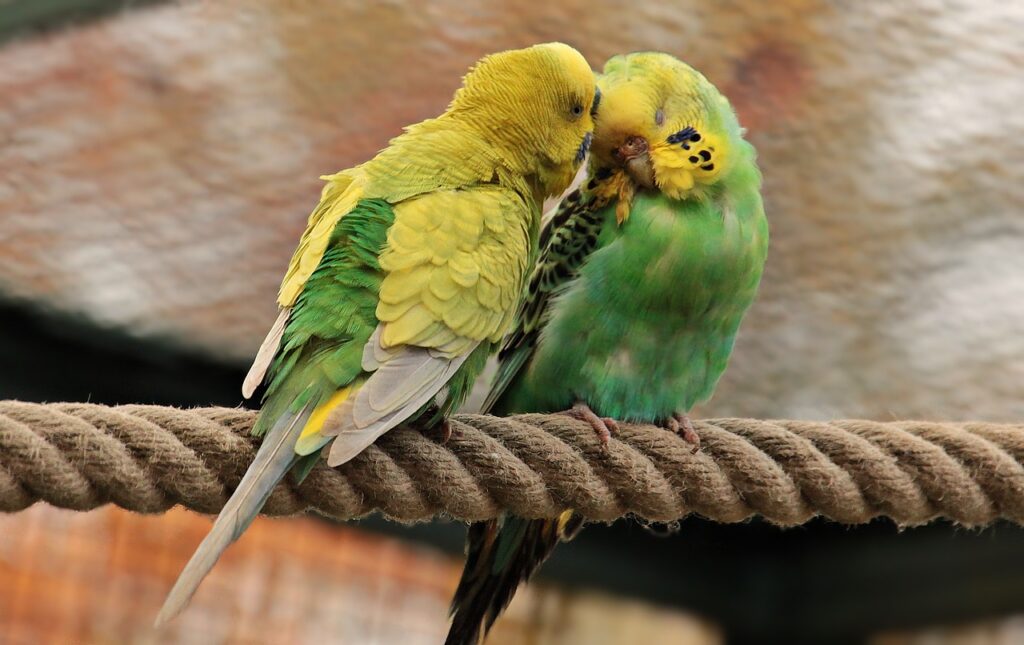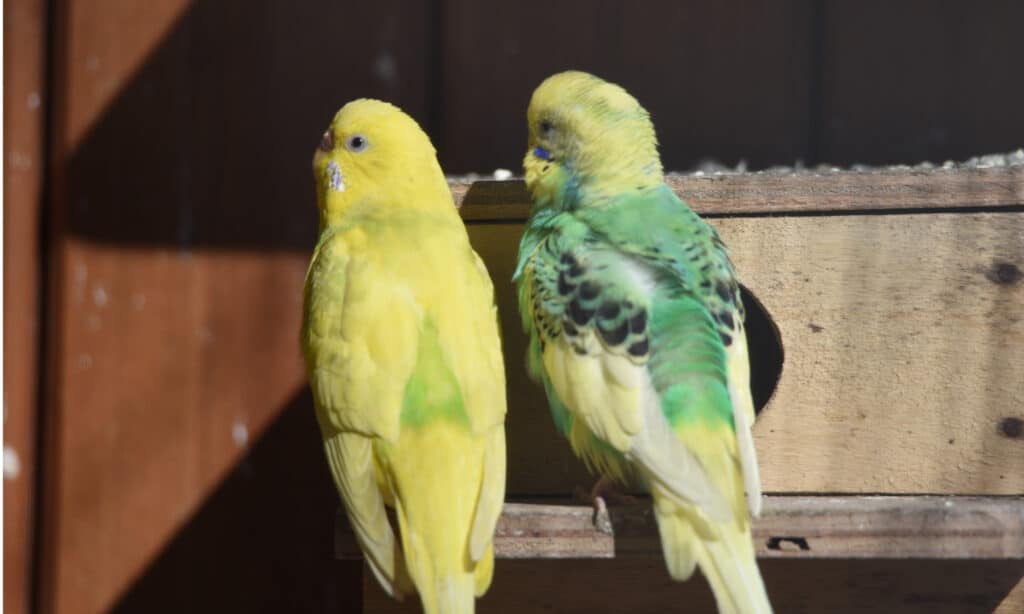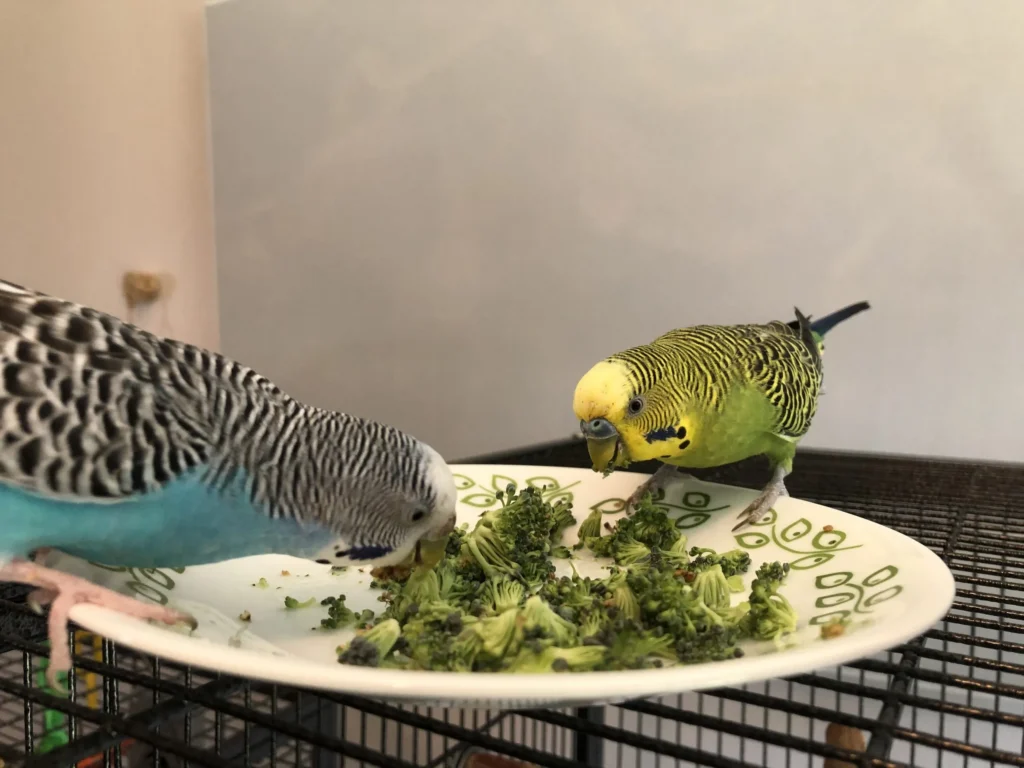“How do parakeets mate?” It’s a question that sparks curiosity among bird enthusiasts and newcomers alike, inviting us to delve into the intricate world of avian reproduction. Parakeets, with their vibrant plumage and endearing personalities, captivate us not only with their charming antics but also with their fascinating mating behaviors. From courtship rituals to the nurturing of young hatchlings, every aspect of parakeet mating unveils a world of natural instincts and unique bonds. In this comprehensive examination, we embark on a journey to unlock the secrets of parakeet reproduction, shedding light on their captivating rituals and the joys – and responsibilities – of welcoming new life into our homes.
Important Points about How Do Parakeets Mate
- Parakeets do courting dances and exhibit mating behaviors including food regurgitation and cuddling.
- The hue of the cere, the fleshy area above the beak, distinguishes males from female parakeets.
- Successful breeding depends on parakeets developing a strong attachment with one another, which is demonstrated by the male feeding the female and the pair sitting closely together.
Introducing our comprehensive examination of parakeet mating and reproduction. This piece will shed light on these endearing birds’ fascinating reproductive habits, including courtship rituals, breeding behavior, egg-laying, and incubation time, as well as the happy arrival of adorable parakeet hatchlings.
Summary Table of Parakeet Mating
| Step | Description |
|---|---|
| Identifying Gender | Males have a completely blue cere and nostrils. Females have a light blue cere and light rings around their nostril holes. |
| Bonding Two Parakeets | Forming a connection is essential for breeding. Signs of bonding include sitting close to one another or the male feeding the female. |
| Choosing the Right Time | Parakeets are usually mature enough to breed after they are one year old. |
| Setting Up A Breeding Cage and Nesting Box | Choose a proper size breeding cage with a separate door to attach a nest box. The cage should have multiple perches, a mineral block, and a cuttlebone for calcium. |
| Breeding Diet for Healthy Chicks | Provide a variety of plentiful and nutritious food. This includes fresh, organic leafy greens, vegetables, fruits, chopped eggs, high-quality seed mix, and pellet mix. |
| Fertilization and Eggs | The female will bend forward and lift up her tail a tiny bit. The male will then move over her and rub his vent against hers to fertilize the eggs. A single parakeet clutch contains between four and five eggs. |
| Parakeet Parenthood | Once the baby parakeets have been born, it is up to you to decide how to care for them. You can either let the parents take care of the chicks, or you can hand-feed them yourself. |
| Hand Feeding Parakeets | If you need to hand-feed your parakeet chicks, they must be removed from the nest box when they are 21 days old and kept in a commercial incubator until they have full feathers. |
| Preventing Breeding | Keep parakeets in separate cages, manipulate their exposure to daylight hours, and remove their nesting box to prevent breeding. |
This table format organizes the information into clear steps and descriptions for each stage of parakeet reproduction.
An Overview of Parakeet Mating
When the parakeets are ready to mate, they will perch next to one another, and the female will elevate her tail and regurgitate her meal for the male. They will also do a great deal of nuzzling and cooing.
Before the eggs hatch, the female will lay them and then keep them warm for 18 to 20 days. A fundamental grasp of mating and gestation is provided by this overview. Since parakeets are most active in the spring, that’s usually when it happens.
Is Your Parakeet Male or Female?
It’s crucial to understand that parakeets are sexually dimorphic in order to distinguish between male and female birds. Just above their beak, males will have a totally blue cere, which is the fleshy area at the base of the beak. Male noses are entirely blue as well.
Contrarily, females will have bright rings surrounding their nasal apertures and a light blue cere. The female’s cere will become tough and tan-brown as they age. When two parakeets are housed together in the absence of other birds, they could give the impression that they are reproducing when, in reality, they are merely two of the same gender.
Bonding of Two Parakeets
Establishing a bond is a crucial step in the parakeet breeding process. It is advisable to select the male and female yourself if you wish to produce parakeets of a specific hue. After that, put the birds in a large cage so they can get used to sharing a home. You can tell by the parakeets’ behavior when they are at ease with one another. They might be seated near to one another or the man tending to the female. At this point, you can be certain that their link is solid.

Choosing the Appropriate Time for Parakeet Mating
A female parakeet’s cere is a good indicator of when she is ready to begin the breeding process; if it appears brown and crunchy, she is ready to go through with it. Once this is done, you can set up your lovebirds’ nesting boxes.

Putting Up A Nesting Box and Breeding Cage
You need a suitable-sized breeding cage for parakeet mating and reproduction to occur successfully. Select one that has a separate door to connect a nest box and measures 24″ long by 12″ wide by 16″ high. Additionally, confirm that it has a cuttlebone for calcium, a mineral block, and many perches. Naturally, there must be a dish for food and water.

The ideal style for a nest box for your parakeets is rectangular, with an aperture on one end and an egg-holding circular depression on the floor. In order to facilitate access to the eggs and the newborns, which need to be checked on a regular basis, the box could additionally include a lid on the top or side.
Make sure it’s safe for your parakeets to be around while choosing materials for their nests. Shreds of newspaper, recyclable paper, and aspen shavings are all safe choices. However, because cedar shavings are harmful, it is not advised to use them. Furthermore, since your parakeet pair prefers a bare cage interior, don’t be concerned if they start pushing the nesting material out of the box.
For optimum health, parakeets need a balance of 12 hours of daylight and 12 hours of darkness. It may be advantageous to expose them to a few more hours of daylight during the mating season.The mother parakeet needs more sunshine to produce vitamin D, which is necessary for strong bones and good eggshells.
Breeding Nutrition for Strong Chicks
Giving your parakeets a wide range of abundant and nourishing food is essential when they are mating. They will be more likely to nest as a result, and their offspring will be healthier. To assist the pair establish ideal breeding conditions and to guarantee that their chicks will continue to consume soft food after they hatch, soft food should be offered to them.

Providing your parakeets with a good food is essential to their continued happiness and well-being. Fresh, organic leafy greens, vegetables, and fruits should be a part of it. Broccoli, peas, carrots, maize, kale, Swiss chard, bananas, apples, roasted sweet potatoes, and bell peppers are healthy options. Another way to provide them with protein is by giving them diced eggs.
You may also provide premium pellet and seed mixes that include omega-3 fatty acids. Make sure you swap out any food that has been out for more than two or three hours for something fresher. The water dish should be changed at least three to four times a day (or whenever it gets filthy) and there should always be a supply of clean water available.
Parakeet Mating: Egg Production and Fertilization
Mating will probably start as soon as the parakeet couple selected for breeding has acclimated to their surroundings completely. It is advised to stop any training that has been conducted with them in the meantime.

Replace their food and water dishes as well as waste trays frequently to keep them healthy. The female will bend forward and slightly elevate her tail when she is ready to procreate. To fertilize the eggs, the male will then move over her and press his vent on hers. The female may deposit an egg every other day as a result of breeding, which might occur many times in a day.
The female parakeet will begin to tear paper and build a nest at the bottom of the cage as a sign that she is ready to deposit an egg. She’ll sit on the bottom of the cage and show indications of tension. A parakeet clutch typically consists of four to five eggs.
The female parakeet will begin incubating her eggs as soon as she has laid them. Usually, she won’t start the incubation process until the nest contains two or three eggs. If the female starts sitting on her eggs right away, the first egg will hatch every other day, taking around eighteen days for each egg to hatch.
Parenting in Parakeets
Hatching is the most delightful aspect of parakeet mating! You have the final say on how to care for the young parakeets when they are born. The chicks can be hand-fed by you, or you can let the parents take care of them. The mother and father are often allowed to nurture their young until they are old enough to be weaned, which is normally around two weeks, according to breeders. Normally, the female parakeet feeds her young after receiving food from the male while she is in the nest.

Feeding Parakeets by Hand
If you choose to hand-feed your parakeet chicks, you must take them out of the nest box at day 21 and place them in a professional incubator until their feathers are fully developed. Using a syringe, feed the chicks formula every three to four hours. Make sure the food is around 105 degrees Fahrenheit to avoid making it too hot for them to digest.

Usually, the formula box will provide instructions on how often to feed the chicks. Ensuring the bird is facing you simplifies the procedure of hand-feeding parakeets. Gently place the syringe’s tip inside the chick’s right beak, angled so that the formula faces the rear left of its mouth. Keep an eye out for the bird bobbling its head as it swallows as you press the syringe.
Giving too much formula at once might result in choking. After that, use a moist, warm paper towel to wipe any formula from the chick’s face, and throw away any formula that is still in the syringe. When you’re done, clean the syringe.
How to Stop Breeding Your Parakeets
If you wish to stop your parakeets from reproducing, there are a few useful techniques to think about. Keeping them in different cages is one of the most dependable methods. This reduces the possibility of an unintentional or undesired mating event in addition to guaranteeing that they stay far from possible mates.
Additionally, varying their exposure to daylight hours is another helpful tactic. Reducing the quantity of natural light they are exposed to can help suppress their procreative impulses.
You may provide them an artificial dusk-like environment that signifies the beginning of night by covering their cage at 6 p.m. This interferes with their natural breeding cycle and aids in regulating their internal biological clock.

Moreover, while attempting to deter parakeets from reproducing, taking away their nesting box is essential. These birds will deposit their eggs and rear their young in a nesting box, which encourages more reproduction. You may take away one of the main factors that promotes reproductive activity by removing this nest-like structure from their cage.
Conclusion
Understanding the intricacies of parakeet mating and reproduction offers a deeper appreciation for these charming birds. From courtship dances to the careful nurturing of hatchlings, every step is a testament to their natural instincts and the bond they form with their mates. By following the guidelines outlined here, enthusiasts can not only witness but also actively support the fascinating journey of parakeet parenthood. However, it’s crucial to acknowledge that while the process is beautiful, responsible breeding requires careful consideration and commitment.
Whether delighting in the arrival of adorable hatchlings or taking measures to prevent unintended breeding, the world of parakeet mating offers a wealth of wonder and responsibility for bird enthusiasts.
